For patients with multiple myeloma, chimeric antigen receptor (CAR) T-cell therapy is gaining ground in pilot studies. At the 2016 American Society of Hematology (ASH) Annual Meeting & Exposition, researchers presented their latest findings for this innovative therapy, which has proven beneficial in other hematologic malignancies.

Multiple myeloma is one of the malignancies for which CAR T-cell therapy holds great promise, [but] we still have a ways to go to find the right antigens.— James Kochenderfer, MD
Tweet this quote
A leading researcher in the field, James Kochenderfer, MD, of the Experimental Transplantation and Immunology Branch of the National Cancer Institute, explained the difficulties that must be overcome for CAR T-cell therapy to work in multiple myeloma.
Target Antigen Is Critical
“Probably the most critical factor for any CAR T-cell therapy is the choice of target antigen. Appropriate target antigens for myeloma are not abundant. Common multiple myeloma antigens such as CD38, CD56, and CD138 are all expressed on essential normal cells as well,” he said. “Another complicating factor is that the myeloma cells of any particular patient are clearly made up of many subclones, so heterogeneity of antigen expression is probable.”
It is thought that the persistence of myeloma depends on a myeloma stem cell that has the phenotype of a mature B cell. Two CAR T-cell approaches in development are targeting B-cell antigens: In research spearheaded by the University of Pennsylvania, anti-CD19 CAR T cells (CTL019) are infused after autologous stem cell transplantation, whereas Baylor College of Medicine researchers are targeting kappa light chains, Dr. Kochenderfer said.
“Targeting myeloma stem cells is an interesting and promising approach, but the results so far are early,” he said. “Also, we need to better define the phenotype of the myeloma stem cell.”
CAR T-Cell Therapy in Myeloma
- Early-phase studies are underway for CAR T-cell therapy in multiple myeloma. Most available data are for anti-CD19 and anti–B-cell maturation antigen approaches.
- In a study of the anti–B-cell maturation antigen product 11D5-3-CD828Z, responses were consistently observed in the 6 patients treated at the highest dose level.
- Another anti–B-cell maturation antigen product, bb2121, completely eradicated tumors in mice and produced robust responses in early
human trials. - Similar activity was observed for the anti-CD19 product, CTL019, in a study in which 8 of 10 patients responded (6 with very good partial responses).
- Efforts are underway to produce more robust, less toxic CAR T-cell products.
Dr. Kochenderfer and his colleagues have taken a somewhat different approach, developing CARs that target B-cell maturation antigen—“B-cell maturation antigen is the target that is expressed most uniformly on myeloma cells and not normal cells. In my opinion, it’s the best known target for CARs in the myeloma field,” he said in an interview with The ASCO Post.
Targeting B-Cell Maturation Antigen
B-cell maturation antigen, a tumor-specific antigen and a receptor for both a proliferation-inducing ligand and B-cell–activating factor, is a member of the tumor necrosis factor receptor superfamily and plays a key role in plasma cell survival. B-cell maturation antigen is expressed in most, if not all, myeloma cells but not in epithelial tissues. B-cell maturation antigen–specific CAR-expressing T lymphocytes specifically recognize and kill B-cell maturation antigen–expressing tumor cells.
At the 2015 ASH Annual Meeting, Dr. Kochenderfer presented a late-breaking abstract on his work with the anti–B-cell maturation antigen CAR T-cell construct, 11D5-3-CD828Z. He reported the first evidence of elimination of measurable multiple myeloma by CAR T cells. The antimyeloma activity of the CAR T cells targeting B-cell maturation antigen increased as the dose of the CAR T cells increased.1
At the 2016 ASH Annual Meeting, he reported that responses were observed in 5 of 6 patients treated at the highest dose level, including a stringent complete response in 1 patient, a very good partial response in 3 patients (1 with 52+ weeks duration), and a partial response in 1 patient.2 These responses occurred, however, at the price of cytokine-release syndrome (which was reversible) and prolonged cytopenias in some patients. Elevations in a variety of serum cytokines, he said, represent “both a major limitation and an opportunity for improvement.”
Patients who obtained significant antimyeloma responses had the highest blood levels of anti–B-cell maturation antigen CAR T cells. This association is similar to what is seen with anti-CD19 CAR T cells, he said. Patients experienced toxicities including fever and low blood pressure, which were also similar to those after infusions of anti-CD19 CAR T cells.
Related Studies
Dr. Kochenderfer also described his work with a second anti–B-cell maturation antigen CAR T-cell product, bb2121. This product contains 4-1bb as a costimulatory domain, designed to better promote proliferation and persistence of the CARs, he said.
In an animal model, he said, “The bb2121 construct eliminated tumors in every mouse. The CAR T-cell–treated mice were all essentially cured. The bortezomib (Velcade)-treated mice had extended survival, but eventually all died. The control group (untreated) all died rapidly.”
In a multicenter phase I dose-escalation study of nine patients with relapsed/refractory myeloma (three per arm), infusions of the lowest dose resulted in one partial response, one disease stabilization, and one disease progression. At the second-highest dose, one very good partial response and two stringent responses were observed, all ongoing. At the highest dose, three partial responses emerged (which could deepen). Cytokine-release syndrome was limited to grade 1 to 2 (no grade 3), and no significant grade 3 neurotoxicity was observed.
“We have found that anti–B-cell maturation antigen CAR T cells have powerful antimyeloma activity against measurable multiple myeloma, including in patients resistant to chemotherapy, though toxicity has been substantial but reversible and similar to that seen on previous CAR T-cell trials in leukemia,” he said. “We are continuing to do preclinical work to come up with CAR T-cell therapies that will have improved efficacy and less toxicity.”
While maintaining that multiple myeloma “is one of the malignancies for which CAR T-cell therapy holds great promise,” Dr. Kochenderfer acknowledged, “We still have a way to go to find the right antigens.”
Anti-CD19 CAR T Cells

Our hypothesis was that CTL019 would prolong response to standard therapy by depleting a minor CD19-positive population of multiple myeloma cells with cancer stem cell properties.— Alfred Garfall, MD
Tweet this quote
An update on a pilot study of an anti-CD19 CAR T-cell approach was presented by Alfred Garfall, MD, of Abramson Cancer Center at the University of Pennsylvania.3 Though CD19 is expressed only rarely on multiple myeloma plasma cells, rare CD19-positive B cells that are clonally related to the myeloma plasma cells can be identified, he said.
“Minor CD19-positive components of the myeloma clone can be identified in patients, and these CD19-positive subsets may have cancer stem cell properties,” Dr. Garfall explained. “Our hypothesis was that CTL019 would prolong response to standard therapy by depleting a minor CD19-positive population of multiple myeloma cells with cancer stem cell properties.”
The approach involved administration of CTL019 after high-dose melphalan and autologous stem cell transplantation in 10 myeloma patients who had disease progression within 1 year of prior first-line stem cell transplant. Patients had received a median of six prior lines of therapy. Poor-prognosis features were present in eight (eg, poor-prognosis cytogenetics, BRAF V600E mutation, secondary plasma cell leukemia). Baseline CD19 expression on myeloma plasma cells showed the dominant population to be CD19-negative in all cases, by flow cytometry, but minor CD19-positive subsets were seen in seven of nine evaluable cases.
“This was a safe and feasible approach,” Dr. Garfall reported. All treated patients received the maximum target dose of 5 × 107 CTL019 cells. One patient experienced grade 1 cytokine-release syndrome, one developed autologous graft-vs-host disease (which resolved), and the other adverse events were as expected posttransplant.
After infusion, CTL019 cells were detectable in the peripheral blood of all subjects and persisted for a median of 44 days (range = 14–156). The presence of CTL019 cells was associated with an absence of peripheral blood B cells. Notably, CTL019 cells were detected in the bone marrow in 9 of 10 subjects at day 42 and/or day 100 post–stem cell transplant.
Key Outcomes
Of the 10 patients treated, 6 achieved very good partial responses by day 100, 2 had partial responses, and 2 continued to have progressive disease. The median progression-free survival after treatment with autologous stem cell transplantation plus CTL019 was 185 days (range = 42–479).
“As expected, most patients had progression early after the second transplant and at a shorter time than after their first-line transplant, but two patients had substantial prolongation of progression-free survival, despite having received a lower dose of melphalan,” he reported. “This compares favorably with our historical cohort of 18 salvage transplants in the ‘modern era,’ where no subjects exhibited longer progression-free survival compared to their prior autologous transplant.”
Also of interest, patients with prolonged remission who eventually had progression exhibited indolent clinical features, ie, “a change in the pace of their disease,” Dr. Garfall said. For example, one patient had undergone an [autologous stem cell transplantation] plus an additional nine lines of treatment. The patient had a 16-month response to [transplant] plus CTL019 and eventually became negative for minimal residual disease. When progression ultimately was observed, it was in the form of extramedullary plasmacytosis, which responded to radiation therapy and daratumumab (Darzalex). The patient has been on daratumumab for more than 1 year now, with no evidence of disease by serum biomarkers.
“What seemed to be a clinical slowing of this patient’s disease was observed despite very brief activity of CTL019,” he added. “CTL019 peaks very early and at a relatively low level, then dissipates by day 100.”
Interestingly, peak bone marrow CTL019 frequency correlated significantly with favorable time to progression (P = .009), but no such associations were observed for CTL019 in the peripheral blood. Also of interest, antibodies emerged against the stem cell antigen Sox2 in subjects with the best clinical outcomes.
The investigators believe that a higher CTL019 dose may increase the proportion of patients who benefit from this treatment. Therefore, they are conducting a phase II trial of CTL019 using a 10-fold higher dose after first-line autologous stem cell transplantation in high-risk myeloma patients. ■
Disclosure: Dr. Kochenderfer has patents and royalties in association with and has received research funding from Kite Pharma and Bluebird Bio.Dr. Garfall has been a consultant for MedImmune and Novartis and has received research funding from Bioinvent and Novartis.
References


